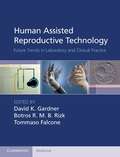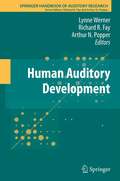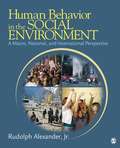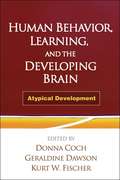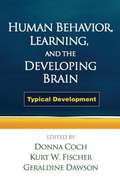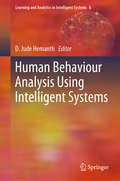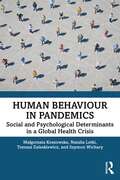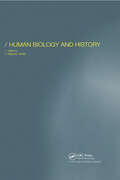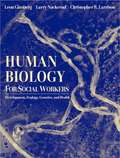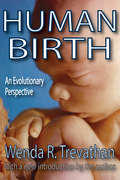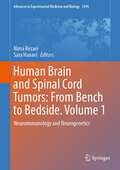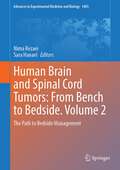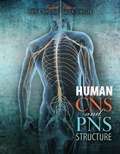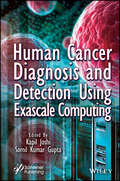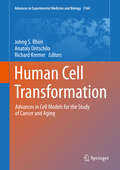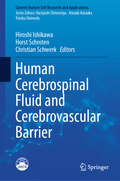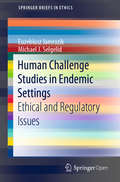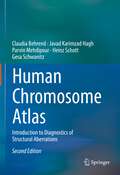- Table View
- List View
Human Assisted Reproductive Technology
by David K. Gardner Tommaso Falcone Botros R. RizkHuman Assisted Reproductive Technology: Future Trends in Laboratory and Clinical Practice offers a collection of concise, practical review articles on cutting-edge topics within reproductive medicine. Each article presents a balanced view of clinically relevant information and looks ahead to how practice will change over the next five years. The clinical section discusses advances in reproductive surgery and current use of robotic surgery for tubal reversal and removal of fibroids. It looks into the refinement of surgical procedures for fertility preservation purposes. Chapters also discuss non-invasive diagnosis of endometriosis with proteomics technology, new concepts in ovarian stimulation and in the management of polycystic ovary syndrome, and evidence-based ART. The embryology section discusses issues ranging from three-dimensional in-vitro ovarian follicle culture, and morphometric and proteomics analysis of embryos, to oocyte and embryo cyropreservation. This forward-looking volume of review articles is key reading for reproductive medicine physicians, gynecologists, reproductive endocrinologists, urologists and andrologists.
Human Auditory Development
by Arthur N. Popper Richard R. Fay Lynne WernerThis volume will provide an important contemporary reference on hearing development and will lead to new ways of thinking about hearing in children and about remediation for children with hearing loss. Much of the material in this volume will document that a different model of hearing is needed to understand hearing during development. The book is expected to spur research in auditory development and in its application to pediatric audiology.
Human Auditory Evoked Potentials
by Terence W. PictonThis book reviews how we can record the human brains response to sounds, and how we can use these recordings to assess hearing. These recordings are used in many different clinical situations the identification of hearing impairment in newborn infants, the detection of tumors on the auditory nerve, the diagnosis of multiple sclerosis. As well they are used to investigate how the brain is able to hear how we can attend to particular conversations at a cocktail party and ignore others, how we learn to understand the language we are exposed to, why we have difficulty hearing when we grow old. This book is written by a single author with wide experience in all aspects of these recordings. The content is complete in terms of the essentials. The style is clear equations are absent and figures are multiple. The intent of the book is to entertain as much as to teach allusions are made to fields beyond the ear and the chapters discuss the importance of the phenomena as well as describing their nature.
Human Behavior In The Social Environment: A Macro, National, And International Perspective
by Rudolph AlexanderHuman Behavior and the Social Environment: A Macro, National, and International Perspective is a textbook for one of the primary courses in the social work curriculum titled Human Behavior in the Social Environment. The course is offered usually over two semesters, with one focusing on micro issues (how the individual develops in relation to their social enviroment on an individual, family, and group level). The second section of the course typically focuses on macro issues pertaining to how an individual is shaped by their social environment by macro issues including social institutions, community, and the government. This book is intended for the second sequence of the course. It takes a unique approach by incorporating international issues of globalization, which has been an emerging issue in social work. Although it takes this unique perspective, it still covers the basics of macro social work on a national level. Other important areas that are not well represented in competing texts includes coverage of rural issues, the impact of hurricane Katrina on social and community resources, human rights and social justice, the increasing impact of increasing rates of incarceration, and a special section focusing on crisis theory. This book has a number of key selling points. They include: A broad national and international perspective A timely approach that examines issues such as rural communities, the impact of disaster on communities, and increasing incarceration rates Provides special emphasis on human needs and social justice End of chapter discussion questions A student glossary Chapter opening photos An appendix that includes three additonal higher level macro theories which would make the book applicable to Master's level program This book will also contain a number of features that are essential for any book to be adopted in a HBSE course. They include: End of chapter discussion questions Instructor's manual featuring powerpoint slides and a test bank Student study site for recommended reading, chapter summaries, and flash cards
Human Behavior, Learning, and the Developing Brain
by Geraldine Dawson Donna CochThoroughly examining brain-behavior relationships in atypically developing children, this important volume integrates theories and data from multiple disciplines. Leading authorities present research on specific clinical problems, including autism, Williams syndrome, learning and language disabilities, ADHD, and issues facing infants of diabetic mothers. In addition, the effects of social stress and maltreatment on brain development and behavior are reviewed. Demonstrating the uses of cutting-edge methods from developmental neuroscience, developmental psychology, and cognitive science, the contributors emphasize the implications of their findings for real-world educational and clinical practices. Illustrations include eight pages in full color.
Human Behavior, Learning, and the Developing Brain
by Donna Coch Kurt FischerThis volume brings together leading authorities from multiple disciplines to examine the relationship between brain development and behavior in typically developing children. Presented are innovative cross-sectional and longitudinal studies that shed light on brain-behavior connections in infancy and toddlerhood through adolescence. Chapters explore the complex interplay of neurobiological and environmental influences in the development of memory, language, reading, inhibitory control, and other core aspects of cognitive, emotional, and social functioning. Throughout, the volume gives particular attention to what the research reveals about ways to support learning and healthy development in all children. Illustrations include four pages in full color.
Human Behaviour Analysis Using Intelligent Systems (Learning and Analytics in Intelligent Systems #6)
by D. Jude HemanthHuman–computer interaction (HCI) is one of the most significant areas of computational intelligence. This book focuses on the human emotion analysis aspects of HCI, highlighting innovative methodologies for emotion analysis by machines/computers and their application areas. The methodologies are presented with numerical results to enable researchers to replicate the work. This multidisciplinary book is useful to researchers and academicians, as well as students wanting to pursue a career in computational intelligence. It can also be used as a handbook, reference book, and a textbook for short courses.
Human Behaviour in Pandemics: Social and Psychological Determinants in a Global Health Crisis
by Malgorzata Kossowska Tomasz Zaleskiewicz Natalia Letki Szymon WicharyThis timely interdisciplinary book brings together a wide spectrum of theoretical concepts and their empirical applications in relation to the COVID-19 pandemic, informing our understanding of the social and psychological bases of a global crisis. Written by an author team of psychologists and sociologists, the volume provides comprehensive coverage of phenomena such as fear, risk, judgement and decision making, threat and uncertainty, group identity and cohesion, social and institutional trust, and communication in the context of an international health emergency.The topics have been grouped into four main chapters, focusing on the individual, group, social, and communication perspectives of the issues affecting or being affected by the pandemic, based on over 740 classic and current references of peer-reviewed research and contextualized with an epidemiological perspective discussed in the introduction. The volume finishes with two special sections, with a chapter on cultural specificity of the social impact of pandemics, focusing specifically on both Islam and Hinduism, and a chapter on the cross-national differences in policy responses to the current health crisis. Providing not just a reference for academic research, but also short-term and long-term policy solutions based on successful strategies to combat adverse social, cognitive, and emotional consequences, this is the ideal resource for academics and policymakers interested in social and psychological determinants of individual reactions to pandemics, as well as in fields such as economics, management, politics, and medical care.
Human Biology and History
by Malcolm SmithThe biology of people in the past is a rapidly expanding field of historical study. Our capacity to understand the biology of historical populations is experiencing remarkable developments on both theoretical and analytical fronts. Human Biology and History weaves together the fields of biology, archaeology, and anthropology in an exchange o
Human Biology for Social Workers: Development, Ecology, Genetics, and Health
by Leon Ginsberg Larry Nackerud Christopher LarrisonThis engaging and accessible supplemental text will give students a basic understanding of human biology and how it relates to human behavior and the social environment. It successfully integrates social work theory with human biology theory.
Human Birth: An Evolutionary Perspective
by Wenda R. TrevathanThe story of human evolution has been told hundreds of times, each time with a focus that seems most informative of the teller. No matter how it is told the primary characters are rarely mothers and infants. Darwin argued survival, but today we know that reproduction is what evolution is all about. Centering on this, Trevathan focuses on birth, which gives the study of human evolution a crucial new dimension.Unique among mammals, humans are bipedal. The evolution of bipedalism required fundamental changes in the pelvis and resulted in a narrow birth canal. Humans are also large-brained animals, which means that birth is much more challenging for our species than for most other animals. The result of this mismatch of large head and narrow pelvis is that women are highly dependent on assistance at birth and their babies are born in an unusually undeveloped state when the brain is still small. Human Birth discusses how the birth process has evolved and ways in which human birth differs from birth in all other mammals.Human Birth is also concerned with mother-infant interaction immediately after birth. While working as a midwife trainee, Trevathan carefully documented the births of more than one hundred women and recorded maternal and infant behaviors during the first hour after birth. She suggests ways in which the interactions served not only to enhance mother-infant bonding, but also to ensure survival in the evolutionary past. With clarity and compelling logic Trevathan argues that modern birth practices often fail to meet evolved needs of women and infants and suggests changes that could lead to better birth experiences. This paperback edition includes a new introduction by the author.
Human Blood Groups
by Geoff DanielsThis new edition of an essential text for all those working within transfusion and blood banking is now even more biologically and clinically relevant, incorporating the latest information on the genes for various blood groups and including greater content on the functional significance of blood groups. The book covers techniques used in blood grouping, troubleshooting and quality assurance and integrates serology with molecular biology, marrying the basic understanding at the genetic level with a cellular understanding of the red blood cell membrane. Now in full colour throughout.
Human Body and the Law: A Medico-legal Study (Edinburgh Law And Society Ser.)
by Robert Maynard HutchinsIn this admirably objective and lucid exposition, the author examines from a medico-legal standpoint the comparative position in various countries, particularly in the UK and the USA, of currently controversial medical procedures: voluntary sterilisation, compulsory sterilisation and castration, trans-sexualism, experimentation, transplantation, and euthanasia - few of which, if any, enjoy a settled or clearly defined place in the eyes of the law. He considers the problems from two perspectives: first, that of the individual in society and how far he himself may determine the extent of physical intrusion on his body; secondly, that of the state or society and how far it may impose or limit medical intrusion on the human body. Thus, Mr. Meyers provides a valuable account, not only of current medical attitudes, but also of relevant case and statute law as it stands at present.It is inherent in the nature of this book that it should arouse controversy and argument. There are many important questions to be debated: Has the state the right to enforce its conception of morality without showing that the behaviour it proscribes has a harmful effect on other members of society? To what extent does consent by the individual concerned insulate a surgeon from criminal liability? In connection with compulsory sterilisation, who is to judge those unfit to procreate? What is a proper definition of medical experimentation? What constitutes death? If a man has a right to live has he not an equal right to die?These are a few of the issues raised. The author has not hesitated to express his own opinions but has clearly relegated them to the summary at the end of each chapter, thereby leaving the objectivity of his main text unimpaired.David W. Meyers is a practicing lawyer in California, with American and British legal qualifications at the firm of Dickenson, Peatman & Fogarty. He has taught at the University of Edinburgh Law School and the University of Tasmania Law School as well as
Human Brain Organoids: Scientific and Ethical Considerations (Collaborative Bioethics #4)
by Insoo Hyun Jeantine E. LunshofBrain organoids are small stem cell-derived, self-organizing models of specific brain regions that offer researchers new ways to study the human brain. Since their scientific debut over ten years ago, brain organoids have been used to generate tractable new bioengineered tools for understanding functional interconnectivity of the human brain, dysfunction involved in many neurodegenerative diseases, and certain molecular mechanisms underlying cognition. Despite this field’s considerable scientific promise, advances in human brain organoid research also raise novel philosophical questions and ethical concerns around the use of complex human brain models and the ethical boundaries that should exist when manipulating increasingly realistic bioengineered brain constructs. As researchers generate more realistic organoids in vitro that resemble human brains, it is critically important to understand what ethical boundaries may exist and where researchers and regulators should draw the line for research, both to reduce uncertainties over which projects to pursue in the lab and to address future concerns regulators and the public may harbor about whether this research, if left unexamined, could inadvertently undermine public trust in science. This proposed book delves into ongoing and proactive ethical discussions among ethicists and the neuroscientists involved with this cutting-edge work. Its ultimate goal is to foster greater awareness, understanding, and guidance for future management of ethical issues that may be unique to new areas of brain organoid research. This volume is the result of a close partnership between ethicists and scientists, each informing the other through a collaborative process of joint bioethical deliberation.
Human Brain and Spinal Cord Tumors: Neuroimmunology and Neurogenetics (Advances in Experimental Medicine and Biology #1394)
by Nima Rezaei Sara HanaeiBrain tumors comprise about 5–9% of all human neoplasms; and interestingly the central nervous system (CNS) neoplasms are ranked among the most prevalent neoplasms of childhood as well. Besides to the morphologic and histopathologic characteristics, and as each pathologic states first starts with molecular alterations, each tumor may have its own story in the matter of activating tumorigenesis pathways and having specific molecular characteristics. Importantly, the molecular classification of tumors has been highly considered in the past few decades for taking the most appropriate therapeutic approach. On the other hand, the tumors shall have tumor-scape mechanisms preventing the immunologic system to eliminate its invasion. The failure of innate and acquired immune system to defeat tumorigenesis mechanisms would consequently result in tumor development. Interestingly, the neuro-immunologic mechanism plays a role in development of psychiatric manifestations of brain tumors as well. Taking all these to account, the different arms of innate immunity, acquired immunity, and genetics have been approached to defeat development and/or progression of such tumors. Accordingly, the activation immunotherapeutic approaches focus on activating or strengthening the anti-tumor immunologic pathways in order to assist the weakened immune system to defeat the tumor (such as Dendritic cell vaccination, DNA vaccines, peptide vaccines, viral vector-based vaccines, monoclonal antibodies, and CAR T-cell therapy). In addition to immunologic components of brain and spinal cord tumors, numerous genes and genetic pathways have been recognized to take part in tumorigenesis. Taking these non-immune genetic pathways to account, some other therapeutic approaches such as stem cell therapy and gene therapy have been developed in the new era of cancer treatment. Moreover, and besides the biologic and medical aspects of these tumors, different physical/mathematical models have been proposed to either explain or predict tumor behavior. Such models would be advantageous in developing new therapeutic modalities in pre-clinical stages and enter new eras in cancer treatment. The first book of Human Brain and Spinal Cord Tumors, Neuro-immunology and Neuro-genetics, will mainly discuss the neuro-immunology and neurogenetic pathways associated with development of brain and spinal cord tumor. After a short introduction chapter, this book will focus on the role of innate and acquired immunity on development of these tumors and then the immunotherapeutic approaches to defeat these tumorigenesis mechanisms. This book will then focus on genetic aspects of brain and spinal cord tumors and bioinformatics models to describe the behavioral patterns of these tumors, as well as associated therapeutic approaches such as stem cell therapy and gene therapy. This volume of book could be useful for experts in basic sciences, mainly geneticists and immunologists, and also physicians of different specialties, mainly neurosurgeons, neurologists, neuropathologists and neuroradiologists.
Human Brain and Spinal Cord Tumors: The Path to Bedside Management (Advances in Experimental Medicine and Biology #1405)
by Nima Rezaei Sara HanaeiThis book aims to gather the current knowledge regarding different aspects of brain and spinal cord tumors in order to more efficiently help the patients. Brain tumors comprise about 5–9% of all human neoplasms; and the central nervous system (CNS) neoplasms are ranked among the most prevalent neoplasms of childhood as well. The more we know about the nature and characteristic of brain and spinal cord tumors, the more precise decision could be made for each patient, in order to reach the best outcome. While surgical resection, chemotherapy, and radiotherapy have been considered as the standards of care for benign and/or malignant CNS tumors since a long time ago, new therapeutic approaches such as immunotherapy have been recently proposed to be considered for treatment of CNS tumors, especially as in some cases, the tumors might be inoperable or the patient may not benefit from other treatment modalities after several recurrences. The second volume of the book focuses on clinical aspects of these tumors. Accordingly, the most important brain and spinal cord tumors are specifically discussed in each chapter based on a rational outlining for all chapter in this volume: Background and epidemiology, genetics, immunology and molecular biology, histopathology and morphology, imaging and radiologic features, clinical manifestations, therapeutic approaches, surgical intervention, chemotherapy and radiotherapy, new therapeutic modalities, follow-up, and prognosis. The chapters of this volume discuss the following pathologies of brain and spinal cord tumors: malignant glioma, benign glioma, meningiomas and other meningeal tumors, ependymomas, medulloblastomas, pineal tumors, choroid plexus and ventricular tumors, neuroectodermal tumors of CNS, neuroepithelial tumors of CNS, pituitary gland tumors, craniopharyngioma, schwannomas and nerve-sheet tumors, hemangioblastomas and other vascular originating tumors, brain and spinal tumors of embryonic origin, germ line cell tumors, malignant bone or cartilage-originating tumors of brain and spine, benign bone or cartilage-originating tumors of brain and spine, brain tumors affecting the orbit globe and orbit tumors affecting the brain, CNS lymphomas, metastatic lesions of the brain and spine, malignant spinal tumors, benign spinal tumors, brain and/or spinal cord tumors accompanied with other diseases or syndromes, psychological and psychiatric aspects of brain and spinal cord tumors, a brief explanation on surgical approaches for treatment of different brain tumors. This volume of book is useful for physicians of different specialties, mainly neurosurgeons, neurologists, neuropathologists, and neuroradiologists.
Human CNS and PNS Structure, Eighth Edition
by Steven R. Torgerud Gale R. LewellenThe text will help the first year chiropractic student in following lectures on the neuroanatomy of the central nervous system (CNS) and peripheral nervous system (PNS). This eighth edition includes material related to the PNS as well as minor updates to the CNS material.
Human Cancer Diagnosis and Detection Using Exascale Computing
by Kapil Joshi Somil Kumar GuptaHuman Cancer Diagnosis and Detection Using Exascale Computing The book provides an in-depth exploration of how high-performance computing, particularly exascale computing, can be used to revolutionize cancer diagnosis and detection; it also serves as a bridge between the worlds of computational science and clinical oncology. Exascale computing has the potential to increase our ability in terms of computation to develop efficient methods for a better healthcare system. This technology promises to revolutionize cancer diagnosis and detection, ushering in an era of unprecedented precision, speed, and efficiency. The fusion of exascale computing with the field of oncology has the potential to redefine the boundaries of what is possible in the fight against cancer. The book is a comprehensive exploration of this transformative unification of science, medicine, and technology. It delves deeply into the realm of exascale computing and its profound implications for cancer research and patient care. The 18 chapters are authored by experts from diverse fields who have dedicated their careers to pushing the boundaries of what is achievable in the realm of cancer diagnosis and detection. The chapters cover a wide range of topics, from the fundamentals of exascale computing and its application to cancer genomics to the development of advanced imaging techniques and machine learning algorithms. Explored is the integration of data analytics, artificial intelligence, and high-performance computing to move cancer research to the next phase and support the creation of novel medical tools and technology for the detection and diagnosis of cancer. Audience This book has a wide audience from both computer sciences (information technology, computer vision, artificial intelligence, software engineering, applied mathematics) and the medical field (biomedical engineering, bioinformatics, oncology). Researchers, practitioners and students will find this groundbreaking book novel and very useful.
Human Capacities and Moral Status
by Russell DisilvestroMany debates about the moral status of things--for example, debates about the natural rights of human fetuses or nonhuman animals--eventually migrate towards a discussion of the capacities of the things in question--for example, their capacities to feel pain, think, or love. Yet the move towards capacities is often controversial: if a human's capacities are the basis of its moral status, how could a human having lesser capacities than you and I have the same "serious" moral status as you and I? This book answers this question by arguing that if something is human, it has a set of typical human capacities; that if something has a set of typical human capacities, it has serious moral status; and thus all human beings have the same sort of serious moral status as you and I. Beginning from what our common intuitions tell us about situations involving "temporary incapacitation"--where a human organism has, then loses, then regains a certain capacity--this book argues for substantive conclusions regarding human fetuses and embryos, humans in a permanent vegetative state, humans suffering from brain diseases, and humans born with genetic disorders. Since these conclusions must have some impact on our ongoing moral and political debates about the proper treatment of such humans, this book will be useful to professionals and students in philosophy, bioethics, law, medicine, and public policy.
Human Cell Transformation: Advances in Cell Models for the Study of Cancer and Aging (Advances in Experimental Medicine and Biology #1164)
by Richard Kremer Johng S. Rhim Anatoly DritschiloThis book, part contributed volume, part proceedings, discusses state-of-the-art advances on human cell transformation in cell models for the study of cancer and aging. Several of the chapters are from the Human Cell Transformation: Advances in Cell Models for the Study of Cancer and Aging conference that was held in June 2018 at McGill University. The authors represent international expertise on a wide variety of topics ranging from different types of cancer (prostate, bone, breast, etc.) to tumor microenvironment, tumor progression, homogeneity, and possible therapies and treatments.
Human Cerebrospinal Fluid and Cerebrovascular Barrier (Current Human Cell Research and Applications)
by Hiroshi Ishikawa Horst Schroten Christian SchwerkThis book offers a basic understanding of the complex mechanisms that protect the brain from harmful substances while still allowing for essential functions such as nutrient transport and waste removal. It explores the blood-cerebrospinal fluid barrier (BCSFB) and the blood-brain barrier (BBB) in depth, focusing on the latest research, innovative techniques, and unique perspectives from researchers worldwide. The book also examines the clinical relevance of brain barrier dysfunction, with a particular focus on multiple sclerosis (MS) and the potential role of brain barriers in the development of MS, intricate relationship between brain barriers and infectious diseases and much more. With contributions from experts in neurobiology, microbiology, and biophysics, this book provides a multidisciplinary perspective. Extensive research has been conducted on the cerebrovascular or cerebrospinal fluid barrier function. The recent development of a functional epithelial cell line derived from a human choroid plexus papilloma has paved the way for an in vitro model of the choroid plexus, which has been instrumental in elucidating the interplay between infection, metabolism, physiological functions, and disease. This book is an effort by the Editors to raise public knowledge of the cerebrovascular and cerebrospinal fluid barriers. With broad coverage of topics in "Human Cerebrospinal Fluid and Cerebrovascular Barrier", it is ideal for researchers studying cerebrovascular or cerebrospinal fluid barrier interested in staying up to date on the latest developments. Healthcare providers and researchers working to develop new treatments for MS, infectious diseases of the central nervous system and other neurological disorders will also value this book. The book provides students of medicine, pharmacy, biology, and engineering with a comprehensive understanding of the structure and function of brain barriers. Those seeking a thorough introduction to the field will also find the book enjoyable.
Human Challenge Studies for Vaccine Development (Current Topics in Microbiology and Immunology #445)
by Rino Rappuoli Giuseppe Del Giudice Fabio Bagnoli Sanjay K. PhogatThis volume offers insights into human challenge studies, where adult volunteers are deliberately infected with a pathogen of interest. These studies can broaden our knowledge on infections that have a rather low natural infection rate, but still bear a great threat to global health. The authors also present instances, where no suitable animal model is available to help understand human immune responses to a specific pathogen. The recent SARS-CoV-2 pandemic is another example, where studies that are directly conducted in humans, could save valuable time. Human challenge studies can provide immunogenicity and early efficacy data for vaccine development. However, similar models could be used for studying a wide variety of medical treatments such as monoclonal antibodies, antibiotics, antivirals and bacteriophages. The chapters in this volume cover several pathogens, including viruses, bacteria and parasites, scientific and technical aspects as well as descriptions of regulatory, ethical and manufacturing requirements. The book serves as a valuable resource for scientists and clinicians working on human pathogens.
Human Challenge Studies in Endemic Settings: Ethical and Regulatory Issues (SpringerBriefs in Ethics)
by Michael J. Selgelid Euzebiusz JamrozikThis open access book provides an extensive review of ethical and regulatory issues related to human infection challenge studies, with a particular focus on the expansion of this type of research into endemic settings and/or low- and middle-income countries (LMICs). Human challenge studies (HCS) involve the intentional infection of research participants, and this type of research is rapidly increasing in frequency worldwide. HCS are widely considered to be an especially promising approach to vaccine development, including for pathogens endemic to LMICs. However, challenge studies are sometimes controversial and raise complex ethical issues, some of which are especially salient in endemic and/or LMIC settings. Informed by qualitative interviews with experts in infectious diseases and bioethics, this book highlights areas of ethical consensus and controversy concerning this kind of research. As the first volume to focus on ethical issues associated with human challenge studies, it sets the agenda for further work in this important area of global health research; contributes to current debates in research ethics; and aims to inform regulatory policy and research practice. Insofar as it focuses on HCS in (endemic) settings where diseases are present and/or widespread, much of the analysis provided here is directly relevant to HCS involving pandemic diseases including COVID19.
Human Chromosome Atlas: Introduction to Diagnostics of Structural Aberrations
by Parvin Mehdipour Claudia Behrend Gesa Schwanitz Javad Karimzad Hagh Heinz SchottNow in its second edition, this atlas serves as an easy-to-use diagnostic guide for the analysis of the human karyotype. Split in four parts, it starts with a comprehensive introduction covering the molecular cytogenetic basics, the role of ethic committees and international quality control in the field of diagnostics. The main parts II and III show the spectrum of different types of chromosomal abnormalities by a combination of karyogram and ideogram. They compare the significance of different banding techniques, give the karyotype formula and describe morphological peculiarities of each case presented. The final part provides a detailed description of non-coding DNA variants and focuses on potential problems in the detection of aberrations. It also mentions necessary additional investigations and peculiarities to be considered when counselling carriers of a chromosomal aberration or their relatives. Given its comprehensive scope and practical approach, this atlas is an indispensable resource for researchers, clinicians and practitioners working in the field of cytogenetics and clinical genetics.
Human Chromosome Variation: Heteromorphism and Polymorphism
by Herman E. Wyandt Vijay S. TonkHuman Chromosome Variation: Heteromorphism and Polymorphism was formerly printed under the title "Atlas of Human Chromosome Heteromorphism". The Atlas has become a standard reference book in most cytogenetic laboratories and is cited as a significant reference in ISCN 2009. This revised version has updated and retained the most useful pictorial sections of the first edition, including the comprehensive review of normal and "not-so-normal" variations of the human karyotype with summaries and extensive reference lists organized by chromosome number. This updated edition features concise background information on chromosome methods and applications, essential information on heteromorphism frequencies in normal and clinical populations as well as new listing and discussions of euchromatic, subtelomeric and FISH variants. The addition of two new sections make this an even more valuable reference than before. A section on common and rare fragile sites includes a short historical discussion, definitions and an extensive table of officially recognized sites that includes the HUGO name, chromosomal location, methods of induction, genes and references to the most recent molecular characterization. A new section on array CGH discusses the clinical challenge of interpreting copy number variations (CNVs) revealed by this newest technology, gives examples of various levels of interpretation and lists the several most common websites used in this interpretation.
